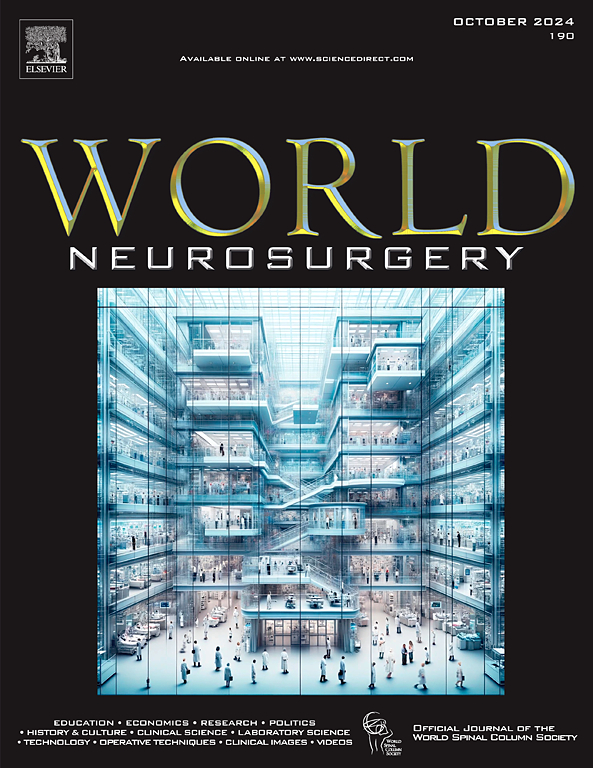Full-Endoscopic Transforaminal Decompression with Modified Reaming Technique on Lateral Recess Stenosis: Outcomes of 155 Cases and Five Years' Experience. A Case Series Study
IF 1.9
4区 医学
Q3 CLINICAL NEUROLOGY
引用次数: 0
Abstract
Objective
Lateral recess stenosis is a degenerative condition caused by a bulging disc, hyperplasia of the superior articular process, and hypertrophy of the ligamentum flavum. The advancement of transforaminal endoscopic lumbar approaches provides effective treatment not only for migrated herniation but also for stenosis. We outlined a modified nonsequential foraminoplasty technique utilizing a trephine and conducted a comprehensive review of our cases to demonstrate safety and efficacy of the procedure.
Methods
Patients with lumbar radiculopathy refractory to conservative treatment, diagnosed with magnetic resonance imaging and diagnostic root blocks, and underwent full-endoscopic transforaminal decompression with the modified nonsequential foraminoplasty technique between April 2017 and September 2022 were included. Those with multiple-level stenosis, previous surgery at the same level, unstable spondylolisthesis, lumbar herniated disc without stenosis, infection, fracture, or tumor were excluded. The study recorded the visual analog scale, Oswestry Disability Index, Modified Macnab criteria, as well as intraoperative and postoperative complications.
Results
One hundred fifty-five patients were included in the study. Clinical and postoperative outcomes revealed significantly lower back and leg visual analog scale scores, as well as Oswestry Disability Index scores at various postoperative time points compared to preoperative values (P < 0.01). At the final follow-up, the modified MacNab criteria were rated as follows: excellent in 65 patients (41.9%), good in 60 patients (38.7%), fair in 2 patients (1.2%), and poor in 28 patients (18.0%).
Conclusions
Full-endoscopic transforaminal decompression using a modified nonsequential foraminoplasty technique is an effective and safe treatment for lumbar lateral recess stenosis.
改良扩孔技术经椎间孔减压治疗侧隐窝狭窄155例临床观察及5年经验。案例系列研究。
目的:外侧隐窝狭窄症(LRS)是一种椎间盘突出、上关节突增生和黄韧带肥大引起的退行性疾病。经椎间孔内窥镜腰椎入路的发展不仅为移位性疝和狭窄提供了有效的治疗方法。我们概述了一种改良的非顺序椎间孔成形术,使用了环钻,并对我们的病例进行了全面的回顾,以证明该手术的安全性和有效性。方法:纳入2017年4月至2022年9月期间,经磁共振成像(MRI)和诊断性根阻滞诊断的腰椎神经根病难以保守治疗的患者,并采用改良的非顺序椎间孔成形术进行全内镜下经椎间孔减压。排除多节段狭窄、既往同一节段手术、不稳定型腰椎滑脱、无狭窄、感染、骨折或肿瘤的腰椎间盘突出者。研究记录了视觉模拟评分(VAS)、Oswestry残疾指数(ODI)、改良Macnab标准以及手术内和术后并发症。结果:155例患者纳入研究。临床和术后结果显示,与术前相比,术后各时间点腰部和腿部视觉模拟评分以及Oswestry残疾指数评分均有显著性差异(P < 0.01)。最终随访时,修改后的MacNab标准评分为:优65例(41.9%),良60例(38.7%),一般2例(1.2%),差28例(18.0%)。结论:采用改良非顺序椎间孔成形术的经椎间孔减压术是治疗腰椎外侧隐窝狭窄的有效且安全的方法。
本文章由计算机程序翻译,如有差异,请以英文原文为准。
求助全文
约1分钟内获得全文
求助全文
来源期刊

World neurosurgery
CLINICAL NEUROLOGY-SURGERY
CiteScore
3.90
自引率
15.00%
发文量
1765
审稿时长
47 days
期刊介绍:
World Neurosurgery has an open access mirror journal World Neurosurgery: X, sharing the same aims and scope, editorial team, submission system and rigorous peer review.
The journal''s mission is to:
-To provide a first-class international forum and a 2-way conduit for dialogue that is relevant to neurosurgeons and providers who care for neurosurgery patients. The categories of the exchanged information include clinical and basic science, as well as global information that provide social, political, educational, economic, cultural or societal insights and knowledge that are of significance and relevance to worldwide neurosurgery patient care.
-To act as a primary intellectual catalyst for the stimulation of creativity, the creation of new knowledge, and the enhancement of quality neurosurgical care worldwide.
-To provide a forum for communication that enriches the lives of all neurosurgeons and their colleagues; and, in so doing, enriches the lives of their patients.
Topics to be addressed in World Neurosurgery include: EDUCATION, ECONOMICS, RESEARCH, POLITICS, HISTORY, CULTURE, CLINICAL SCIENCE, LABORATORY SCIENCE, TECHNOLOGY, OPERATIVE TECHNIQUES, CLINICAL IMAGES, VIDEOS
 求助内容:
求助内容: 应助结果提醒方式:
应助结果提醒方式:


